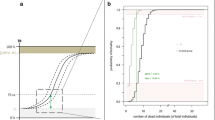Abstract
In dose–response analysis, regression analysis and hypothesis testing are the main tools of choice. These methods, however, have specific requirements for the design of acute toxicity experiments. To produce meaningful results, both approaches require a constant exposure concentration over the duration of the test, and regression analysis makes an additional demand for at least two doses with partial mortality at the end of the test. These requirements, however, result from the limitations of the statistical techniques, which only use the observations at the end of the test. In practice, most standard protocols for acute testing prescribe that observations are made at several points in time (often daily). In this contribution, I demonstrate how dynamic modelling can make use of this information to produce robust estimates of LC50 as function of time, with confidence intervals, from data sets that violate the requirements for standard dose–response analysis. This form of modelling invites an entirely different, more flexible, view on experimental design, which could lead to a more efficient use of test animals and, at the same time, a stronger support for environmental risk assessment as well as the science of ecotoxicology.



Similar content being viewed by others
References
Albert C, Ashauer R, Künsch HR, Reichert P (2012) Bayesian experimental design for a toxicokinetic–toxicodynamic model. J Stat Plan Inference 142:263–275
Ashauer R, Escher BI (2010) Advantages of toxicokinetic and toxicodynamic modelling in aquatic ecotoxicology and risk assessment. J Environ Monit 12:2056–2061
Ashauer R, Caravatti I, Hintermeister A, Escher BI (2010a) Bioaccumulation kinetics of organic xenobiotic pollutants in the freshwater invertebrate Gammarus pulex modeled with prediction intervals. Environ Toxicol Chem 29:1625–1636
Ashauer R, Hintermeister A, Caravatti I, Kretschmann A, Escher BI (2010b) Toxicokinetic and toxicodynamic modeling explains carry-over toxicity from exposure to diazinon by slow organism recovery. Environ Sci Technol 44:3963–3971
Ashauer R, Agatz A, Albert C, Ducrot V, Galic N, Hendriks J, Jager T, Kretschmann A, O’Connor I, Rubach MN, Nyman AM, Schmitt W, Stadnicka J, Van den Brink PJ, Preuss TG (2011a) Toxicokinetic–toxicodynamic modeling of quantal and graded sublethal endpoints: a brief discussion of concepts. Environ Toxicol Chem 30:2519–2524
Ashauer R, Wittmer I, Stamm C, Escher BI (2011b) Environmental risk assessment of fluctuating diazinon concentrations in an urban and agricultural catchment using toxicokinetic–toxicodynamic modeling. Environ Sci Technol 45:9783–9792
Ashauer R, Hintermeister A, O’Connor I, Elumelu M, Hollender J, Escher BI (2012) Significance of xenobiotic metabolism for bioaccumulation kinetics of organic chemicals in Gammarus pulex. Environ Sci Technol 46:3498–3508
Ashauer R, Thorbek P, Warinton JS, Wheeler JR, Maund S (2013) A method to predict and understand fish survival under dynamic chemical stress using standard ecotoxicity data. Environ Toxicol Chem 32:954–965
Baas J, Jager T, Kooijman SALM (2009) Estimation of no effect concentrations from exposure experiments when values scatter among individuals. Ecol Model 220:411–418
Bedaux JJM, Kooijman SALM (1994) Statistical analysis of bioassays based on hazard modelling. Environ Ecol Stat 1:303–314
Geiger DL, Northcott CE, Call DJ, Brooke LT (1985) Acute toxicities of organic chemicals to fathead minnows (Pimephales promelas), vol 2. University of Wisconsin-Superior, Superior, WI
Geiger DL, Call DJ, Brooke LT (1988) Acute toxicities of organic chemicals to fathead 323 minnow (Pimephales promelas), vol 4. Center for Lake Superior Environmental 324 Studies, University of Wisconsin-Superior, Superior, WI
Green JW, Springer TA, Stavely JP (2012) The drive to ban the NOEC/LOEC in favor of ECx is misguided and misinformed. Integr Environ Assess Manag 9:12–16
Hoekstra JA (1991) Estimation of the LC50, a review. Environmetrics 2:139–152
Jager T (2011) Some good reasons to ban ECx and related concepts in ecotoxicology. Environ Sci Technol 45:8180–8181
Jager T, Kooijman SALM (2009) A biology-based approach for quantitative structure–activity relationships (QSARs) in ecotoxicity. Ecotoxicology 18:187–196
Jager T, Zimmer EI (2012) Simplified dynamic energy budget model for analysing ecotoxicity data. Ecol Model 225:74–81
Jager T, Heugens EHW, Kooijman SALM (2006) Making sense of ecotoxicological test results: towards application of process-based models. Ecotoxicology 15:305–314
Jager T, Albert C, Preuss TG, Ashauer R (2011) General unified threshold model of survival—a toxicokinetic–toxicodynamic framework for ecotoxicology. Environ Sci Technol 45:2529–2540
Kooijman SALM (1996) An alternative for NOEC exists, but the standard model has to be abandoned first. Oikos 75:310–316
Kretschmann A, Ashauer R, Hitzfeld K, Spaak P, Hollender J, Escher BI (2011) Mechanistic toxicodynamic model for receptor-mediated toxicity of diazoxon, the active metabolite of diazinon, in Daphnia magna. Environ Sci Technol 45:4980–4987
Landis WG, Chapman PM (2011) Well past time to stop using NOELs and LOELs. Integr Environ Assess Manag 7:vi–viii
Newman MC, McCloskey JT (2000) The individual tolerance concept is not the sole explanation for the probit dose-effect model. Environ Toxicol Chem 19:520–526
Nyman AM, Schirmer K, Ashauer R (2012) Toxicokinetic–toxicodynamic modelling of survival of Gammarus pulex in multiple pulse exposures to propiconazole: model assumptions, calibration data requirements and predictive power. Ecotoxicology 21:1828–1840
OECD (1992) OECD guideline for testing of chemicals 203. Fish, acute toxicity test. Organisation for Economic Cooperation and Development (OECD), Paris
OECD (2006) Current approaches in the statistical analysis of ecotoxicity data: a guidance to application, series on testing and assessment, no. 54. Organisation for Economic Cooperation and Development (OECD), Paris
Rufli H, Springer TA (2011) Can we reduce the number of fish in the OECD acute toxicity test? Environ Toxicol Chem 30:1006–1011
Sprague JB (1969) Measurement of pollutant toxicity to fish. I. Bioassay methods for acute toxicity. Water Res 3:793–821
van Ommen Kloeke AE, Jager T, van Gestel CAM, Ellers J, van Pomeren M, Krommenhoek T, Styrishave B, Hansen M, Roelofs D (2012) Time-related survival effects of two gluconasturtiin hydrolysis products on the terrestrial isopod Porcellio scaber. Chemosphere 89:1084–1090
Acknowledgments
This research has been financially supported by the European Union under the 7th Framework Programme (project acronym CREAM, contract number PITN-GA-2009-238148).
Author information
Authors and Affiliations
Corresponding author
Electronic supplementary material
Below is the link to the electronic supplementary material.
Rights and permissions
About this article
Cite this article
Jager, T. Reconsidering sufficient and optimal test design in acute toxicity testing. Ecotoxicology 23, 38–44 (2014). https://doi.org/10.1007/s10646-013-1149-7
Accepted:
Published:
Issue Date:
DOI: https://doi.org/10.1007/s10646-013-1149-7




